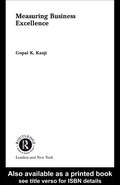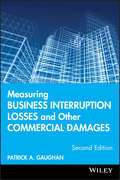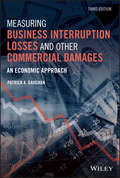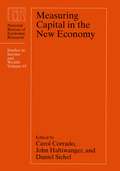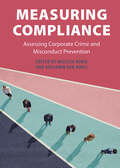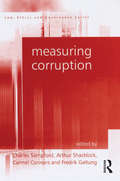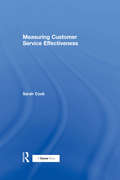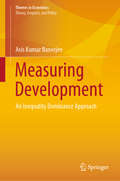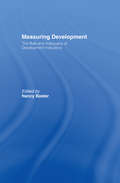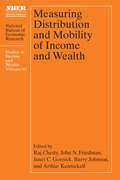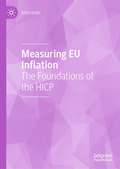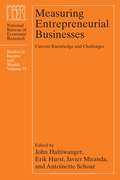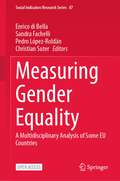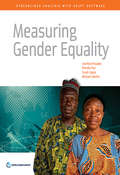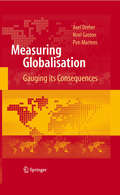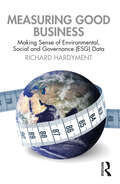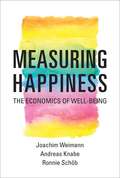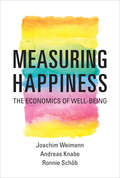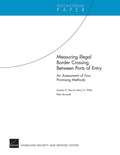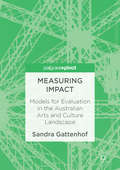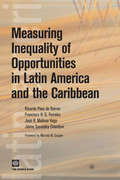- Table View
- List View
Measuring Business Excellence (Routledge Advances in Management and Business Studies #Vol. 21)
by Gopal K. KanjiBusiness Excellence and Total Quality Management (TQM) models provide a means of measuring the satisfaction of customers, employees and shareholders simultaneously. A number of such models currently exist, but, the author argues, none of these address all dimensions of TQM.This book introduces the principles of TQM, and establishes their use in measuring Business Excellence in an organisational environment. It comparatively evaluates various TQM and Business Excellence models, and discusses the complexities of measuring success.Presenting important, innovative work by one of the most eminent scholars in the field, this book is essential reading for both academics and professionals working in quality management.
Measuring Business Interruption Losses and Other Commercial Damages
by Gaughan Patrick A.An updated explanation of the methodology for how lost profits should be measured Now fully revised and updated, focused on commercial litigation and the many common types of cases, this is the only book in the field to explain the complicated process of measuring business interruption damages. The book features an easy to understand and apply, step-by-step process for how losses should be measured so as to be accurate and reliable and consistent with the relevant laws. With a new chapter on the economics of punitive damages, the new edition also explains detailed methods for measuring damages in contract litigation, intellectual property lawsuits, antitrust, and securities cases. This new Second Edition incorporates the latest developments in the fields of economics and accounting, while also integrating the most current changes in case law. Here's what you will find Each chapter includes new materials and updated content Added websites for sources of data Includes a website for updated tables that can be utilized by readers A section of the new cases involving Daubert challenges to economists Includes methods on how to do industry research A new section covering the equity risk premium and the various recent research studies, which set forth the debate on what the premium should be Containing exhibits, tables, and graphs, new cases involving Dauber, how to do industry research, equity risk premium, research studies on the marketability discount, anti-trust, punitive damages, and more, Measuring Business Interruption Losses and Other Commercial Damages, Second Edition incorporates the relevant literature and research that has come out in this field over the past four years.
Measuring Business Interruption Losses and Other Commercial Damages: An Economic Approach
by Patrick A. GaughanMeasure business interruption losses with confidence You hope for the best and plan for the worst. It’s your job. But when the unimaginable happens, are you truly prepared for those business interruption losses? Measuring Business Interruption Losses and Other Commercial Damages is the only book in the field that explains the complicated process of measuring business interruption damages after you’ve been hit by the unexpected, whether the losses are from natural or man-made disasters, or whether the performance of one company adversely affects the performance of another. Understand the methodology for how lost profits should be measured Deal with the many common types of cases in business interruption lawsuits in commercial litigation Take a look at exhibits, tables, and graphs Benefit from updated data, case studies, and case law references Don’t get caught off guard. Get ahead of planning for measuring your interruption losses before disaster strikes.
Measuring Capital in the New Economy
by John Carol Daniel Corrado Haltiwanger SichelAs the accelerated technological advances of the past two decades continue to reshape the United States' economy, intangible assets and high-technology investments are taking larger roles. These developments have raised a number of concerns, such as: how do we measure intangible assets? Are we accurately appraising newer, high-technology capital? The answers to these questions have broad implications for the assessment of the economy's growth over the long term, for the pace of technological advancement in the economy, and for estimates of the nation's wealth. In Measuring Capital in the New Economy, Carol Corrado, John Haltiwanger, Daniel Sichel, and a host of distinguished collaborators offer new approaches for measuring capital in an economy that is increasingly dominated by high-technology capital and intangible assets. As the contributors show, high-tech capital and intangible assets affect the economy in ways that are notoriously difficult to appraise. In this detailed and thorough analysis of the problem and its solutions, the contributors study the nature of these relationships and provide guidance as to what factors should be included in calculations of different types of capital for economists, policymakers, and the financial and accounting communities alike.
Measuring Capital in the New Economy
by John Haltiwanger Carol Corrado Daniel SichelAs the accelerated technological advances of the past two decades continue to reshape the United States' economy, intangible assets and high-technology investments are taking larger roles. These developments have raised a number of concerns, such as: how do we measure intangible assets? Are we accurately appraising newer, high-technology capital? The answers to these questions have broad implications for the assessment of the economy's growth over the long term, for the pace of technological advancement in the economy, and for estimates of the nation's wealth. In Measuring Capital in the New Economy, Carol Corrado, John Haltiwanger, Daniel Sichel, and a host of distinguished collaborators offer new approaches for measuring capital in an economy that is increasingly dominated by high-technology capital and intangible assets. As the contributors show, high-tech capital and intangible assets affect the economy in ways that are notoriously difficult to appraise. In this detailed and thorough analysis of the problem and its solutions, the contributors study the nature of these relationships and provide guidance as to what factors should be included in calculations of different types of capital for economists, policymakers, and the financial and accounting communities alike.
Measuring Compliance: Assessing Corporate Crime and Misconduct Prevention
by Benjamin Van Rooij Melissa RorieCompliance, or the behavioral response to legal rules, has become an important topic for academics and practitioners. A large body of work exists that describes different influences on business compliance, but a fundamental challenge remains: how to measure compliance or noncompliance behavior itself? Without proper measurement, it's impossible to evaluate existing management and regulatory enforcement practices. Measuring Compliance provides the first comprehensive overview of different approaches that are or could be used to measure compliance by business organizations. The book addresses the strengths and weaknesses of various methods and offers both academics and practitioners guidance on which measures are best for different purposes. In addition to understanding the importance of measuring compliance and its potential negative effects in a variety of contexts, readers will learn how to collect data to answer different questions in the compliance domain, and how to offer suggestions for improving compliance measurement.
Measuring Corruption (Law, Ethics And Governance Ser.)
by Arthur Shacklock Fredrik GaltungWith the advance of an increasingly globalized market, the opportunities for, and scale of, corruption is growing. The size of corporations and their wealth relative to nations provides the resources for corrupt practices. The liberalization of international financial markets makes transferring and hiding the proceeds of corruption easier. Moves towards privatization in East and West are providing once-only incentives for corruption on an unprecedented scale, as officials not only deal with the income of the state, but with its assets as well. In this book, Transparency International's (TI) world-renowned 'Corruption Perception Index' (CPI) and 'Bribery Perception Index' (BPI) are explained and examined by a group of experts. They set out to establish to what extent they are reliable measures of corruption and whether a series of surveys can measure changes in corruption and the effectiveness of anti-corruption strategies. The book contains a variety of expert contributions which deal with the complexity, difficulty and potential for measuring corruption as the key to developing effective strategies for combating it.
Measuring Customer Experience
by Philipp KlausNow, more than ever, customer experience plays a pivotal role in the success and longevity of a company. Based on rigorous scientific tools and global data, this book offers a simple but thorough guide on how to master the challenges of the market, and how to deliver superior performance through effective customer experience management.
Measuring Customer Service Effectiveness
by Sarah CookGood customer service may be seen as a crucial asset for most organisations. But how do you know that you are delivering good customer service both externally and internally and, more importantly, delivering it to meet and exceed your customers' expectations? Customer service is an intangible thing, it is perishable and it is personal, so measuring it can be complicated and less than straightforward. Help is at hand. Sarah Cook's down-to-earth guide provides the rationale behind measuring service effectiveness externally and internally and explains the measurement process, from preparation to managing the results. The book also includes an exploration of the various techniques open for measuring effectiveness and how to use them. Utilising her consultancy experiences the author has ensured that there is plenty of ready-to-use materials to enable you to start measuring your own organisation's service effectiveness straight away.
Measuring Development: An Inequality Dominance Approach (Themes in Economics)
by Asis Kumar BanerjeeThis book discusses how to measure the level of development of an economy, particularly, the task of ranking economies in terms of their development. In this context, development is defined as an increase in people’s level of wellbeing. The book emphasises that wellbeing is a multidimensional concept, and that it is important to ask how equitably the fruits of development are distributed, and as such it focuses on multidimensional, inequality-sensitive development ranking. Rather than using various specific development indices, which would lead to different development rankings for a country, the book proposes a dominance approach, which formulates conditions under which two economies can be ranked unambiguously, making it valid for all reasonable development indices. With the help of illustrative examples using real-world data, it demonstrates that such unambiguous rankings are possible, and that the proposed approach can be used to complement traditional approaches. An invaluable resource for researchers working in the field of development, the book will also appeal to practitioners engaged in measuring development.An excerpt from the book's Foreword:"[This book] is a comprehensive and valuable contribution to the literature on the measurement of inequality and the use of such measurement in the assessment of social welfare. I believe that it will be of much interest to researchers working on measures of inequality and social welfare as well as advanced graduate students who are looking for a solid introduction to this important area of normative economics."- Prof. Prasanta K. Pattanaik, University of California, Riverside, California, U.S.A.
Measuring Development: the Role and Adequacy of Development Indicators
by Nancy BasterFirst published in 1972. Routledge is an imprint of Taylor & Francis, an informa company.
Measuring Distribution and Mobility of Income and Wealth: Studies in Income and Wealth (National Bureau of Economic Research Conference Report)
by Raj Chetty, John N. Friedman, Janet C. Gornick, Barry Johnson and Arthur KennickellA collection of twenty-three studies that explore the latest developments in the analysis of income and wealth distribution and mobility. Economic research is increasingly focused on inequality in the distribution of personal resources and outcomes. One aspect of inequality is mobility: are individuals locked into their respective places in this distribution? To what extent do circumstances change, either over the lifecycle or across generations? Research not only measures inequality and mobility, but also analyzes the historical, economic, and social determinants of these outcomes and the effect of public policies. This volume explores the latest developments in the analysis of income and wealth distribution and mobility. The collection of twenty-three studies is divided into five sections. The first examines observed patterns of income inequality and shifts in the distribution of earnings and in other factors that contribute to it. The next examines wealth inequality, including a substantial discussion of the difficulties of defining and measuring wealth. The third section presents new evidence on the intergenerational transmission of inequality and the mechanisms that underlie it. The next section considers the impact of various policy interventions that are directed at reducing inequality. The final section addresses the challenges of combining household-level data, potentially from multiple sources such as surveys and administrative records, and aggregate data to study inequality, and explores ways to make survey data more comparable with national income accounts data.
Measuring EU Inflation: The Foundations of the HICP
by John AstinThe HICP is a consumer price index which was designed to provide measures of inflation in EU member states calculated using similar methods and thus comparable one with another. The HICP now tracks the inflation rates covering over 500 million Europeans, including the UK, and is also produced by other countries such as the USA. John Astin was the EU statistician in charge of the initial development of this important index and he has the best knowledge of how it was developed in the 1990s. This book is a history of the main development period of the HICP, up to the year 2002 when Astin left the European Commission. It will be of interest to a wide range of readers, not only in the UK but globally. Types of readers are likely to include: economists, economic statisticians, national statistics offices, universities, libraries, government finance/economic ministries, international organizations such as UN, ILO, OECD, EU, Eurostat, ECB, and central banks, as well as individuals who are interested in the construction of consumer price indices. This book begins by explaining the background to the HICP project, both from an economic and a political viewpoint, and describes the specific needs for harmonized price indices resulting from the Maastricht treaty of 1992. It analyses the process of establishing the necessary procedures for taking this urgent work forward and gives details of the technical issues involved, and the critical issue of drafting legal acts which would be necessary to ensure full compliance with the new rules. It includes analysis of products, price collection issues, quality adjustment, timing, and a host of other issues, and discusses the arguments which had to be resolved, as well as some human aspects of the process too. It also looks at the funding aspects, the recruitment of specialist consultants, the legal processes and the organization of meetings, both in Luxembourg and in other countries.
Measuring Economic Sustainability and Progress
by Dale W. Jorgenson J. Steven Landefeld Paul SchreyerSince the Great Depression, researchers and statisticians have recognized the need for more extensive methods for measuring economic growth and sustainability. The recent recession renewed commitments to closing long-standing gaps in economic measurement, including those related to sustainability and well-being. The latest in the NBER's influential Studies in Income and Wealth series, which has played a key role in the development of national account statistics in the United States and other nations, this volume explores collaborative solutions between academics, policy researchers, and official statisticians to some of today's most important economic measurement challenges. Contributors to this volume extend past research on the integration and extension of national accounts to establish an even more comprehensive understanding of the distribution of economic growth and its impact on well-being, including health, human capital, and the environment. The research contributions assess, among other topics, specific conceptual and empirical proposals for extending national accounts.
Measuring Entrepreneurial Businesses: Current Knowledge and Challenges
by Antoinette Schoar John Haltiwanger Erik Hurst Javier MirandaStart-ups and other entrepreneurial ventures make a significant contribution to the US economy, particularly in the tech sector, where they comprise some of the largest and most influential companies. Yet for every high-profile, high-growth company like Apple, Facebook, Microsoft, and Google, many more fail. This enormous heterogeneity poses conceptual and measurement challenges for economists concerned with understanding their precise impact on economic growth. Measuring Entrepreneurial Businesses brings together economists and data analysts to discuss the most recent research covering three broad themes. The first chapters isolate high- and low-performing entrepreneurial ventures and analyze their roles in creating jobs and driving innovation and productivity. The next chapters turn the focus on specific challenges entrepreneurs face and how they have varied over time, including over business cycles. The final chapters explore core measurement issues, with a focus on new data projects under development that may improve our understanding of this dynamic part of the economy.
Measuring Gender Equality: A Multidisciplinary Analysis of Some EU Countries (Social Indicators Research Series #87)
by Christian Suter Pedro López-Roldán Sandra Fachelli Enrico Di BellaIn this open access book, the editors explicitly address the issue of measuring gender equality. The book introduces readers to basic concepts of gender equality, equity and equal opportunities, then discusses measuring these phenomena, the methods of constructing indicators, and reviews the main indicators that have been proposed at the international level to measure gender equality. It then sets the theoretical discussions against the findings from a Jean Monnet project financed by the European Union to highlight the importance of a regional analysis of gender equality in four main study areas: Italy, Spain, France and Germany. The results make it clear that it is necessary to move from the purely national perspective hitherto used in gender equality analyses to a regional one because differences can be highly pronounced even within the same country. This is a self-contained volume requiring limited statistical expertise for the reader and is aimed at social researchers and policymakers who wish to address gender equality from a quantitative perspective.
Measuring Gender Equality: Streamlined Analysis with ADePT Software
by Zurab Sajaia Josefina Posadas Lokshin Pierella PaciGender equality is a core development objective in its own right and also smart development policy and business practice. No society can develop sustainably without giving men and women equal power to shape their own lives and contribute to their families, communities, and countries. And yet, critical gender gaps continue to exist in all countries and across multiple dimensions. The gender module of the World Bank’s ADePT software platform produces a comprehensive set of tables and graphs using household surveys to help diagnose and analyze the prevailing gender inequalities at the country level and over time. This book provides a step-by-step guide to the use of the ADePT software and an introduction to its basic economic concepts and econometric methods. The module is organized around the framework proposed by the World Development Report 2012: Gender Equality and Development. It covers gender differences in outcomes in three primary dimensions of gender equality: human capital (or endowments), economic opportunities, and voice and agency. Particular focus is given to the analysis and decomposition techniques that allow for further exploring of gender gaps in economic opportunities.
Measuring Globalisation
by Pim Martens Axel Dreher Noel GastonGlobalisation is a timely and controversial topic. Against the chorus of globalisation's proponents and detractors, the authors propose an approach for measuring globalisation and its consequences. Undertaking a comprehensive review of the literature on globalisation and using data from the MGI and KOF indices, the well-respected authors build a framework for defining globalisation and analyzing the relationships among economic, political, and social variables.
Measuring Good Business: Making Sense of Environmental, Social and Governance (ESG) Data
by Richard HardymentWhat's a good company? Environmental, Social and Governance (ESG) investing is transforming the world of business and finance. Investors are using data on issues like climate and diversity to enhance returns and make an impact. But with scepticism creeping in, how far can we trust the numbers? Is all this data making a difference to people and planet, and have we actually lost sight of what we are measuring and why? Measuring Good Business explains what we can measure – and calls for honesty about what we can't.This is the first book to look at the numbers behind the ESG revolution. It sets out a bold blueprint to revolutionise the data based on bottom-up, inclusive metrics, customised data to meet investor needs and impact measures that put sustainability in context. It is essential reading for anyone creating, using or studying ESG and sustainability data. After unpacking what’s going on today, the book focuses on solutions, providing a how-to guide to improve measurement and make sustainable business more impactful. It shows why measurement matters in a highly accessible way through stories and insights based on practical experience.The book is relevant to a broad readership of data creators (e.g. those working in companies), users (e.g. capital market participants) as well as the large ecosystem of raters, rankers and standard setters across the private, public and non-profit worlds.
Measuring HR Alignment
by Dave Ulrich Brian E. Becker Mark A. HuselidAlignment, a word that seems to be on everyone's lips in the business world these days, requires that human resource and line managers develop a shared view of HR's role. This chapter introduces several different approaches to measuring your organization's alignment between the HR system that produces key HR deliverables and the requirements of the firm's strategy implementation system.
Measuring Happiness
by Ronnie Schöb Joachim Weimann Andreas KnabeCan money buy happiness? Is income a reliable measure for life satisfaction? In the West after World War II, happiness seemed inextricably connected to prosperity. Beginning in the 1960s, however, other values began to gain ground: peace, political participation, civil rights, environmentalism. "Happiness economics" -- a somewhat incongruous-sounding branch of what has been called "the dismal science" -- has taken up the puzzle of what makes people happy, conducting elaborate surveys in which people are asked to quantify their satisfaction with "life in general." In this book, three economists explore the happiness-prosperity connection, investigating how economists measure life satisfaction and well-being.The authors examine the evolution of happiness research, considering the famous "Easterlin Paradox," which found that people's average life satisfaction didn't seem to depend on their income. But they question whether happiness research can measure what needs to be measured. They argue that we should not assess people's well-being on a "happiness scale," because that necessarily obscures true social progress. Instead, rising income should be understood as increasing opportunities and alleviating scarcity. Economic growth helps societies to sustain freedom and to finance social welfare programs. In this respect, high income may not buy happiness with life in general, but it gives individuals the opportunity to be healthier, better educated, better clothed, and better fed, to live longer, and to live well.
Measuring Happiness: The Economics of Well-Being (The\mit Press Ser.)
by Joachim Weimann Andreas Knabe Ronnie SchobAn investigation of the happiness-prosperity connection and whether economists can measure well-being.Can money buy happiness? Is income a reliable measure for life satisfaction? In the West after World War II, happiness seemed inextricably connected to prosperity. Beginning in the 1960s, however, other values began to gain ground: peace, political participation, civil rights, environmentalism. “Happiness economics”—a somewhat incongruous-sounding branch of what has been called “the dismal science”—has taken up the puzzle of what makes people happy, conducting elaborate surveys in which people are asked to quantify their satisfaction with “life in general.” In this book, three economists explore the happiness-prosperity connection, investigating how economists measure life satisfaction and well-being.The authors examine the evolution of happiness research, considering the famous “Easterlin Paradox,” which found that people's average life satisfaction didn't seem to depend on their income. But they question whether happiness research can measure what needs to be measured. They argue that we should not assess people's well-being on a “happiness scale,” because that necessarily obscures true social progress. Instead, rising income should be understood as increasing opportunities and alleviating scarcity. Economic growth helps societies to sustain freedom and to finance social welfare programs. In this respect, high income may not buy happiness with life in general, but it gives individuals the opportunity to be healthier, better educated, better clothed, and better fed, to live longer, and to live well.
Measuring Illegal Border Crossing Between Ports of Entry
by Henry H. Willis Peter Brownell Andrew R. MorralThe U.S. Department of Homeland Security is responsible for controlling the flow of goods and people across the U.S. border, but compelling methods for producing estimates of the total flow of illicit goods or border crossings do not yet exist. This paper describes four innovative approaches to estimating the total flow of illicit border crossings between ports of entry. Each approach is sufficiently promising to warrant further attention.
Measuring Impact
by Sandra GattenhofThis book investigates the relationship developed between the researcher/evaluator and the commissioning arts and cultural producer in providing an opportunity to rethink the traditional process of reporting back on value and impact through the singular entity of funds acquittal. Using three commissioned evaluations as examples, the discussion outlines the two positions most often adopted by researchers/evaluators, external and distanced or embedded and collaborative, and will argue the merits and deficiencies of the two approaches. This text also investigates the role of the researcher/evaluator as a broker of stakeholder interests; how cultural organizations can partner in data gathering and develop a participatory approach to the research; what role the researcher/evaluator can have in the dissemination of evaluation findings and recommendations; and makes recommendations on which partnership type is more affective in a commissioned evaluation model for an arts and culture organization in the Australian landscape.
Measuring Inequality of Opportunities in Latin America and the Caribbean
by Ricardo Paes de Barros Francisco H. G. Ferreira Jaime Saavedra Chanduvi Jose R. Molinas VegaEquality of opportunity is about leveling the playing field so that circumstances such as gender, ethnicity, place of birth, or family background do not influence a person's life chances. Success in life should depend on people's choices, effort and talents, not to their circumstances at birth. 'Measuring Inequality of Opportunities in Latin America and the Caribbean' introduces new methods for measuring inequality of opportunities and makes an assessment of its evolution in Latin America over a decade. An innovative Human Opportunity Index and other parametric and non-parametric techniques are presented for quantifying inequality based on circumstances exogenous to individual efforts. These methods are applied to gauge inequality of opportunities in access to basic services for children, learning achievement for youth, and income and consumption for adults.
